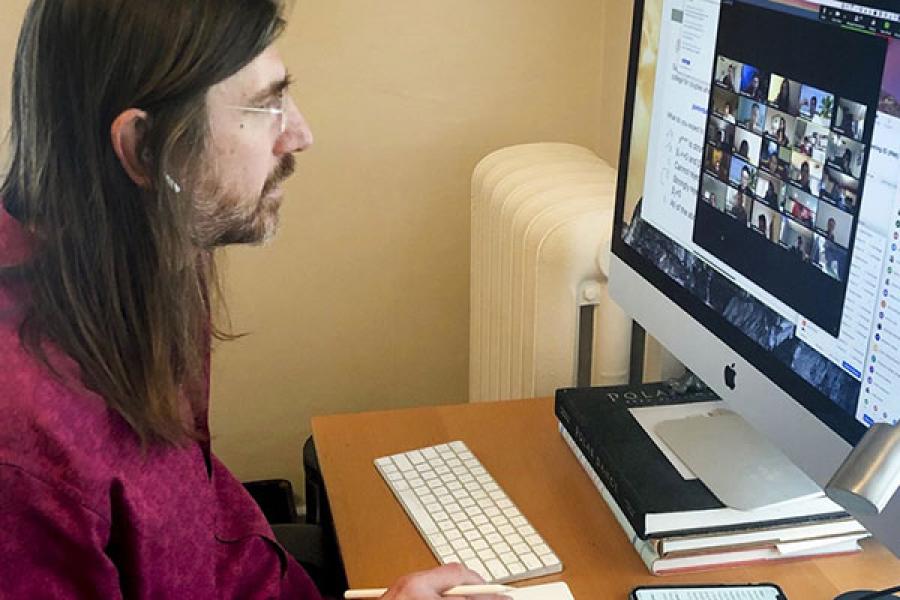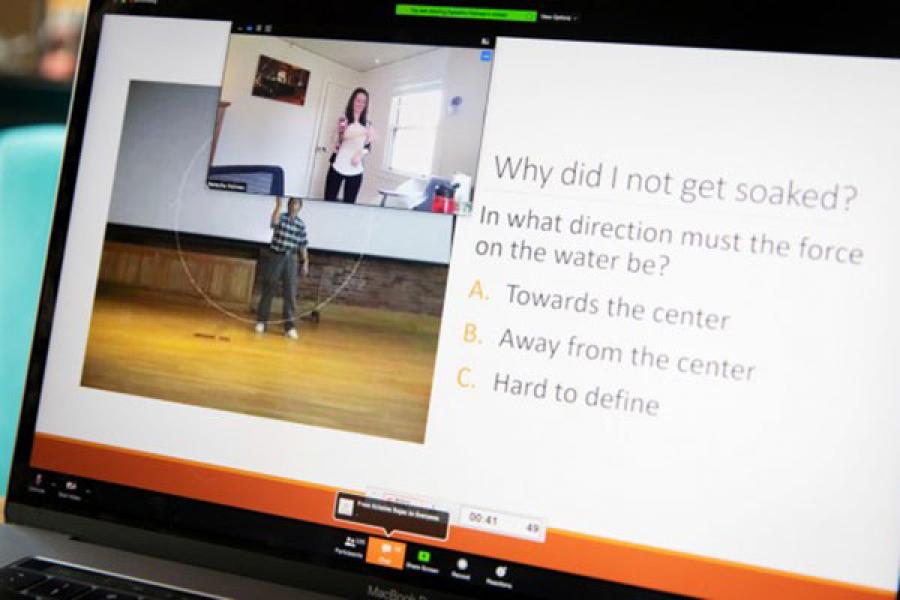At around 1:25 p.m. on April 7, students began streaming into the Zoom meeting for ECON 3120, Applied Econometrics – much as they used to stream into G76 Goldwin Smith Hall in person.
By the time Doug McKee, senior lecturer in economics in the College of Arts and Sciences (A&S), began the class, 97 of the course’s 130 students had popped up onscreen – an impressive number, considering they knew the class would be recorded to watch later. And when McKee directed them into breakout rooms to solve a problem together, it worked.
“It went remarkably similar to how I’d hoped and planned it would,” McKee said. “I have a 27-inch screen, so it took a little bit of time to move everything around so I could see what I wanted to see. I have a colleague who said she felt like an airline pilot – you really do have quite the dashboard when you’re teaching these big classes.”
Doug McKee, senior lecturer in economics, teaches his Applied Econometrics class via Zoom.
On April 6 – the first day of virtual instruction for the Ithaca campus after a three-week pause, which included spring break – Cornell instructors led 6,600 Zoom meetings with a total of 89,000 participants.
“This is an amazing number of instructors and students engaged in online learning, many of them completely new to this mode of teaching and learning,” said Julia Thom-Levy, vice provost for academic innovation and professor of physics in A&S. “Of course there are issues to iron out. We have to run like this for a little while before we can be sure of the outcomes, but we can already tell that students and faculty were well prepared for Monday morning.”
That preparation was weeks in the making. The Center for Teaching Innovation (CTI) and Cornell Information Technology (CIT) – together with staff from Cornell University Library, eCornell, the Learning Strategies Center, Student Disability Services, the Office of Engagement Initiatives, Global Learning and others – worked closely with each other to support instructors and students.
“The deans, associate deans, department chairs and staff members have been essential in this process of linking instructors with the right support, whether hardware or pedagogical, hosting an array of training sessions,” said Mathew Ouellett, CTI’s executive director.
CIT extended Zoom licensing for large meetings and webinars and expanded VPN capacity, in addition to working with Zoom for enhanced security settings.
Ensuring that Zoom settings are secure amid national news about hacking created a flurry of activity late last week, said Benjamin Finio, part-time lecturer in the Sibley School of Mechanical and Aerospace Engineering, who works with CTI’s Active Learning Initiative and has been helping engineering faculty prepare for the transition.
“We’ve all been on Zoom meetings where it’s, ‘We can’t hear you, can you hear me?’ and that really wasn’t an issue in the class,” said Finio, who sat in on an 8:40 a.m. April 6 Zoom lecture for MAE 2030, Dynamics – among the first classes held on the first day.
“We’ve already gotten some feedback from students,” Finio said. “At a lecture Monday, the professor didn’t have his camera on, and the student said it would be nice to see his face. We have professors who really want to have a gallery of students with their cameras on, but we know there are students wearing pajamas in messy bedrooms who don’t want to do that. So I’m sure that will fluctuate from class to class and evolve over the next few weeks.”
Natasha Holmes, the Ann S. Bowers Assistant Professor in the College of Arts & Sciences, leads a remote lecture for her course Physics of the Heavens and the Earth from her home during the first week of virtual instruction. Credit: Lindsay France/Cornell University
As McKee prepared, he consulted at least a half-dozen staff members in CTI for help – including a question five minutes before his first class, when he noticed an unusual setting in Zoom and got an immediate response that fixed the problem. After his April 7 lecture, he held virtual office hours, which he said felt very similar to the in-person version.
“I asked how it went, and the students said they really liked seeing their friends,” he said. “So having those breakout rooms and having some time in class for peer-to-peer interactions – it seemed like they were starving for that. In addition to being good for learning, just giving them that opportunity to talk to each other was pretty useful.”
During the last few weeks, faculty have asked questions about privacy and copyright, about how to assess learning in an online environment, about the security of the tools Cornell is using and about supporting students who are now living all over the world, Thom-Levy said. She said students are concerned about fair grading, privacy and participation given the range of time zones and other challenges.
“These are valid concerns and need thoughtful solutions,” she said. “At the same time, the teaching community is building empathy and support for each other. All the work we’re doing now continues to flow from our commitment to student-centered learning and inclusion. These values continue to shape the way we think about teaching, learning and engaging with each other in the future.”
Read the story in the Cornell Chronicle








